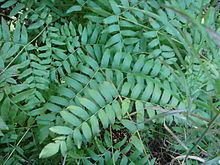Order Osmundales Genus Osmunda | Division Pteridophyta Rank Species | |
 | ||
Class Polypodiopsida / Pteridopsida (disputed) Similar Nemastylis floridana, Nolina atopocarpa, Warea carteri, Platanthera nivea, Asplenium serratum | ||
Osmunda spectabilis is a species of fern once thought to be the same as Osmunda regalis, but recent genetic studies have shown it to be a separate species.
Contents
Description
Osmunda spectabilis is an easy fern to recognize in the New World flora. Although it closely resembles species O. regalis, O. japonica, and O. lancea, only O. spectabilis is found growing naturally in the New World. The fronds of O. spectabilis can exceed 1 meter in length and are bipinnate. The pinnules are attached by a very narrow base. The plant produces separate sterile and fertile fronds. Fertile fronds are similar to the sterile fronds, in the lower and middle portions, but the top-most pinnae are fertile and they are much reduced and brown when mature in the early summer.
Taxonomy
Osmunda spectabilis was formerly considered to be a variety of Osmunda regalis (Osmunda regalis var. spectabilis). Another variety, Osmunda spectabilis var. brasiliensis, (formerly Osmunda regalis var. brasiliensis) also exists in tropical regions of Central and South America, but it is only recognized by some authors.
Osmunda angustifolia, Osmunda bromeliifolia, and all extinct Osmunda species are missing from this cladogram. The classification is based on the genetic analysis presented in "The Paraphyly of Osmunda is Confirmed by Phylogenetic Analyses of Seven Plastid Loci."
Distribution and Habitat
American royal fern is most commonly found growing in wetter soils such as those found in wet forests, bogs, and along streams and lakes.
